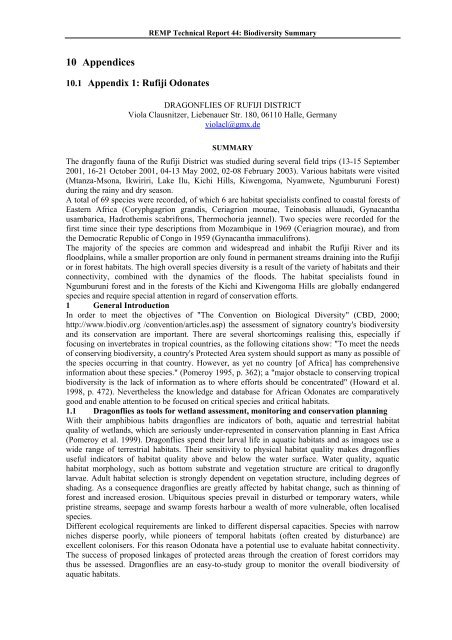Family / Scientific name - Coastal Forests of Kenya and Tanzania
Family / Scientific name - Coastal Forests of Kenya and Tanzania
Family / Scientific name - Coastal Forests of Kenya and Tanzania
Create successful ePaper yourself
Turn your PDF publications into a flip-book with our unique Google optimized e-Paper software.
10 Appendices<br />
10.1 Appendix 1: Rufiji Odonates<br />
REMP Technical Report 44: Biodiversity Summary<br />
DRAGONFLIES OF RUFIJI DISTRICT<br />
Viola Clausnitzer, Liebenauer Str. 180, 06110 Halle, Germany<br />
violacl@gmx.de<br />
SUMMARY<br />
The dragonfly fauna <strong>of</strong> the Rufiji District was studied during several field trips (13-15 September<br />
2001, 16-21 October 2001, 04-13 May 2002, 02-08 February 2003). Various habitats were visited<br />
(Mtanza-Msona, Ikwiriri, Lake Ilu, Kichi Hills, Kiwengoma, Nyamwete, Ngumburuni Forest)<br />
during the rainy <strong>and</strong> dry season.<br />
A total <strong>of</strong> 69 species were recorded, <strong>of</strong> which 6 are habitat specialists confined to coastal forests <strong>of</strong><br />
Eastern Africa (Coryphgagrion gr<strong>and</strong>is, Ceriagrion mourae, Teinobasis alluaudi, Gynacantha<br />
usambarica, Hadrothemis scabrifrons, Thermochoria jeannel). Two species were recorded for the<br />
first time since their type descriptions from Mozambique in 1969 (Ceriagrion mourae), <strong>and</strong> from<br />
the Democratic Republic <strong>of</strong> Congo in 1959 (Gynacantha immaculifrons).<br />
The majority <strong>of</strong> the species are common <strong>and</strong> widespread <strong>and</strong> inhabit the Rufiji River <strong>and</strong> its<br />
floodplains, while a smaller proportion are only found in permanent streams draining into the Rufiji<br />
or in forest habitats. The high overall species diversity is a result <strong>of</strong> the variety <strong>of</strong> habitats <strong>and</strong> their<br />
connectivity, combined with the dynamics <strong>of</strong> the floods. The habitat specialists found in<br />
Ngumburuni forest <strong>and</strong> in the forests <strong>of</strong> the Kichi <strong>and</strong> Kiwengoma Hills are globally endangered<br />
species <strong>and</strong> require special attention in regard <strong>of</strong> conservation efforts.<br />
1 General Introduction<br />
In order to meet the objectives <strong>of</strong> "The Convention on Biological Diversity" (CBD, 2000;<br />
http://www.biodiv.org /convention/articles.asp) the assessment <strong>of</strong> signatory country's biodiversity<br />
<strong>and</strong> its conservation are important. There are several shortcomings realising this, especially if<br />
focusing on invertebrates in tropical countries, as the following citations show: "To meet the needs<br />
<strong>of</strong> conserving biodiversity, a country's Protected Area system should support as many as possible <strong>of</strong><br />
the species occurring in that country. However, as yet no country [<strong>of</strong> Africa] has comprehensive<br />
information about these species." (Pomeroy 1995, p. 362); a "major obstacle to conserving tropical<br />
biodiversity is the lack <strong>of</strong> information as to where efforts should be concentrated" (Howard et al.<br />
1998, p. 472). Nevertheless the knowledge <strong>and</strong> database for African Odonates are comparatively<br />
good <strong>and</strong> enable attention to be focused on critical species <strong>and</strong> critical habitats.<br />
1.1 Dragonflies as tools for wetl<strong>and</strong> assessment, monitoring <strong>and</strong> conservation planning<br />
With their amphibious habits dragonflies are indicators <strong>of</strong> both, aquatic <strong>and</strong> terrestrial habitat<br />
quality <strong>of</strong> wetl<strong>and</strong>s, which are seriously under-represented in conservation planning in East Africa<br />
(Pomeroy et al. 1999). Dragonflies spend their larval life in aquatic habitats <strong>and</strong> as imagoes use a<br />
wide range <strong>of</strong> terrestrial habitats. Their sensitivity to physical habitat quality makes dragonflies<br />
useful indicators <strong>of</strong> habitat quality above <strong>and</strong> below the water surface. Water quality, aquatic<br />
habitat morphology, such as bottom substrate <strong>and</strong> vegetation structure are critical to dragonfly<br />
larvae. Adult habitat selection is strongly dependent on vegetation structure, including degrees <strong>of</strong><br />
shading. As a consequence dragonflies are greatly affected by habitat change, such as thinning <strong>of</strong><br />
forest <strong>and</strong> increased erosion. Ubiquitous species prevail in disturbed or temporary waters, while<br />
pristine streams, seepage <strong>and</strong> swamp forests harbour a wealth <strong>of</strong> more vulnerable, <strong>of</strong>ten localised<br />
species.<br />
Different ecological requirements are linked to different dispersal capacities. Species with narrow<br />
niches disperse poorly, while pioneers <strong>of</strong> temporal habitats (<strong>of</strong>ten created by disturbance) are<br />
excellent colonisers. For this reason Odonata have a potential use to evaluate habitat connectivity.<br />
The success <strong>of</strong> proposed linkages <strong>of</strong> protected areas through the creation <strong>of</strong> forest corridors may<br />
thus be assessed. Dragonflies are an easy-to-study group to monitor the overall biodiversity <strong>of</strong><br />
aquatic habitats.

















